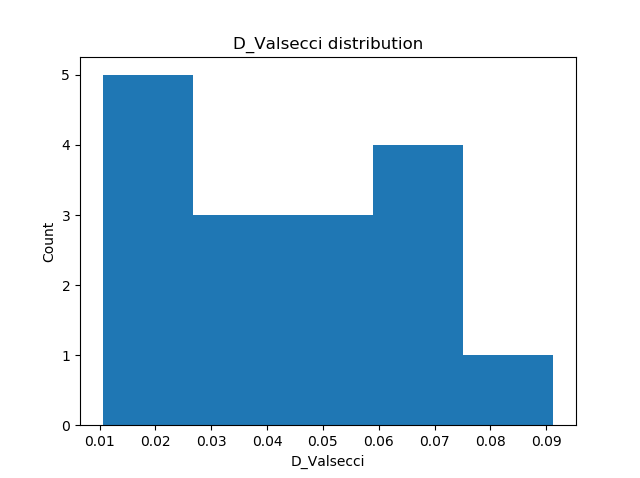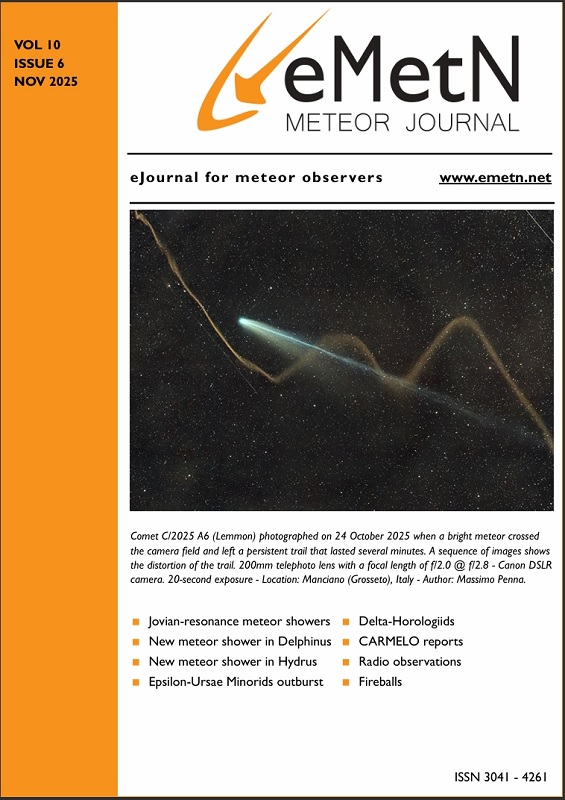By Damir Šegon, Denis Vida and Paul Roggemans
Abstract: A new meteor shower on a LPC-type orbit has been detected in 2022 by the Global Meteor Network during the time interval 282.41° < λʘ < 282.83° (2022, January 2–3) from a radiant at R.A. = 219° and Decl.= +28° with a geocentric velocity of 58.9 km/s. The new meteor shower has been listed in the Working List of Meteor Showers under the temporary identification M2023-D1.
Introduction
Verification of older radiant plots of the Global Meteor Network revealed a radiant concentration south of the Quadrantid radiant, active for as little as 10 hours during the night of 2–3 January 2022 (Figure 1).

Figure 1 – Radiant plot of the Global Meteor Network data for 2022 January 2–3 in Sun-centered geocentric ecliptic coordinates. The new radiant is visible south of the QUA radiant and is marked by a red arrow.
Meteor shower search methodology
The method has been described in Šegon et al. (2023), but for this specific case we choose not to use the Southworth and Hawkins (1963) D-criterion, but the criterion defined by Valsecci et al. (1999). The idea to use another discrimination criterion is to show that this method works regardless the kind of criterion which is applied. The resulting distribution of D-criteria plotted as a histogram (Figure 2) allows us to select the histogram bin containing most meteors.

Figure 2 – Histogram of the distribution of the values of the DV criterion valid for the first mean orbit estimate.

Figure 3 – Rayleigh distribution fit and DV cutoff.

Figure 4 – All radiants in geocentric equatorial coordinates during the shower activity. The gray crosses are the new shower radiants, you can see the QUA radiants in the upper left.

Figure 5 – The reverse of Figure 4 where the background radiants are now grayed out, all radiants in geocentric equatorial coordinates. The QUA shower radiants may be clearly seen as a separate group of orbits at their expected radiant positions (up and left from the new shower).
The Rayleigh distribution fit results in DV = 0.09. The resulting mean orbit calculated with the method of Jopek et al. (2006) is listed in Table 1. The radiant plot in equatorial coordinates is shown in Figures 4 and 5. The activity period appears to be very short, about 10 hours within the interval 282.41° < λʘ < 282.83° (Figure 6).

Figure 6 – The activity period with the number of orbits identified as new shower members.

Figure 7 – The diagram of the inclination i against longitude of perihelion Π. The QUA shower radiants may be clearly seen as a separate group of orbits (down and right from the new shower).
New shower or existing shower?
Verification of the IAU MDC Working List of Meteor Showers (Jenniskens et al., 2020; Jopek and Kaňuchová, 2014; 2017; Jopek and Jenniskens, 2011; Neslušan et al., 2020) reveals two meteoroid streams with the same type of orbits. One shower is active the same date, the other one more than 10 days later in time with slightly different radiant positions, in equatorial and in Sun-centered ecliptic coordinates.
Both the Southworth and Hawkins as well as the Drummond D-criteria exceed the upper limits to suggest any similarity. All three orbits in Table 1 are Long Period-type comet (LPC) retrograde orbits, but differ mainly in longitude of perihelion. Nevertheless, the occurrence within a period of weeks with radiants not too far apart may suggest some common origin for these same orbit type meteoroid streams. The ten-hour duration activity observed in 2022 could not be associated with any existing shower and therefore has been suggested as a new meteor shower.
Table 1 – Known neighboring showers, Canum Venaticids-Bootids (TCV#0579) and Serpentids-Coronae Borealids (RSE#0594), both (Gural et al., 2014) and the new meteor shower.
| TCV | RSE | New | |
| λʘ (°) | 282 | 298 | 282.66 |
| λʘb (°) | 275 | 293 | 282.4 |
| λʘe (°) | 288 | 303 | 282.85 |
| αg (°) | 210.1 | 234.9 | 218.8 |
| δg (°) | +29.4 | +25.1 | +28.2 |
| Δαg (°) | 0.69 | 0.71 | – |
| Δδg (°) | –0.17 | –0.20 | – |
| vg (km/s) | 59.9 | 56.6 | 58.9 |
| λ (°) | 195.3 | 224.5 | 204.9 |
| λg – λʘ (°) | 273.3 | 286.5 | 282.2 |
| βg (°) | +38.6 | +43.2 | +40.8 |
| a (A.U.) | 7.0 | 10.9 | 14.9 |
| q (A.U.) | 0.977 | 0.902 | 0.9296 |
| e | 0.861 | 0.917 | 0.9375 |
| i (°) | 113.7 | 103.7 | 109.1 |
| ω (°) | 171.6 | 145.9 | 153.1 |
| Ω (°) | 281.8 | 298.4 | 282.7 |
| Π (°) | 93.4 | 84.3 | 75.7 |
| Tj | 0.27 | 0.21 | -0.04 |
| N | 21 | 17 | 18 |
Another search method
Another method has been applied to search for this new meteor shower combining three different discrimination criteria (Roggemans et al., 2019).

Figure 8 – Close up of the Sun-centered ecliptic geocentric coordinates for the possible new shower and the two known showers TCV and RSE.
This stream search detects 18 similar orbits in the 2022 data but with a large dispersion. Only 6 of these orbits fit with DSH < 0.1 and DD < 0.04. The large spread is very well visible in the Sun-centered ecliptic coordinates (Figure 8). The positions of the Canum Venaticids-Bootids (TCV#0579) and Serpentids-Coronae Borealids (RSE#0594) are also marked in this plot to show the offset relative to the radiants of the new shower. The diagram of inclination i against the longitude of perihelion Π (Figure 9) shows the large dispersion in longitude of perihelion.

Figure 9 – Diagram of the inclination i against the longitude of perihelion Π for the new shower and the two known showers TCV and RSE.
The 6 best fitting orbits within the interval 282.43° < λʘ < 282.85°, according to this method yield a mean orbit which is in good agreement with the results presented in Table 1.
- a = 17.9 AU
- q = 0.926 AU
- e = 0.948
- i = 110.9°
- Ω = 283.1°
- ω = 151.9°
- Π = 75.0
- Tj = –0.12
Comparing older data and datasets
Looking up past years orbit data for Global Meteor Network, we find only 4 similar orbits with DSH < 0.1 and DD < 0.04 for 2023. Checking the CAMS data for 2011–2016 we find 13 similar orbits with DSH < 0.1 and DD < 0.04, one or few each year, spread in time. The SonotaCo data for 2007–2022 yield 4 orbits with DSH < 0.1 and DD < 0.04, only one for 2022 at λʘ = 284.0° but nothing during the activity interval according to GMN although SonotaCo had 47 orbits collected in 2022 during this interval. And EDMOND data for 2006–2016 had only 4 similar orbits with DSH < 0.1 and DD < 0.04.
The new shower appears also as a group of unidentified radiants on the CAMS map for 2022, January 2–3 (Figure 10). However, this data includes GMN data and it is not possible to select only CAMS data in this display. As CAMS data has not been released publicly since 2016, no comparison is possible.

Figure 10 – Radiant plot for CAMS on 2022 January 3. The radiant concentration is indicated with a red arrow.
Conclusion
A new meteor shower radiant has been discovered in Global Meteor Network data around 2022 January 2–3 at R.A. = 218.7° and Decl. = +28.0°. A mean orbit could be established based on 19 orbits. The new shower may be related to two nearby meteoroid streams, Canum Venaticids-Bootids (TCV#0579) and Serpentids-Coronae Borealids (RSE#0594) which have the same type of orbit.
The new meteor shower has been reported to the IAU and has been listed in the Working List of Meteor Showers under the temporary identification M2023-D1.
Acknowledgment
The authors thank all people who support the Global Meteor Network by contributing meteor camera data or in any other way to help monitoring meteor activity around the clock worldwide. For the list of GMN contributors we refer to Šegon et al. (2023).
References
Drummond J. D. (1981). “A test of comet and meteor shower associations”. Icarus, 45, 545–553.
Gural P., Šegon D., Andreić Ž., Skokić I., Korlević K., Vida D., Novoselnik F., Gostinski D. (2014). “Results of CMN 2013 search for new showers across CMN and SonotaCo databases II”. WGN, Journal of the International Meteor Organization, 42, 132–138.
Jenniskens P., Jopek T. J., Janches D., Hajduková M., Kokhirova G. I., Rudawska R. (2020). “On removing showers from the IAU Working List of Meteor Showers”. Planetary and Space Science, 182, article id. 104821.
Jopek T. J., Rudawska R. and Pretka-Ziomek H. (2006). “Calculation of the mean orbit of a meteoroid stream”. Monthly Notices of the Royal Astronomical Society, 371, 1367–1372. Jopek T. J., Jenniskens P. M. (2011). “The Working Group on Meteor Showers Nomenclature: A History, Current Status and a Call for Contributions”. In, W.J. Cooke, D.E. Moser, B.F. Hardin, and D. Janches, editors, Meteoroids: The Smallest Solar System Bodies, Proceedings of the Meteoroids Conference held in Breckenridge, Colorado, USA, May 24-28, 2010. NASA/CP-2011-216469, pages 7–13.
Jopek T. J., Kaňuchová Z. (2014). “Current status of the~IAU MDC Meteor Showers Database”. In, T.J. Jopek, F.J.M. Rietmeijer, J. Watanabe, I.P. Williams, editors, Meteoroids 2013 Proceedings of the Astronomical Conference held at A.M. University, Poznan, Poland, Aug. 26-30, 2013, A.M. University Press, pages 353–364.
Jopek T. J., Kaňuchová Z. (2017). “IAU Meteor Data Center-the shower database: A status report”. Planetary and Space Science, 143, 3–6.
Neslušan L., Poručan V., Svoreň J., Jakubík M. (2020). “On the new design othe IAU MDC portal”. WGN, Journal of the International Meteor Organization, 48, 168–169.
Roggemans P., Johannink C. and Campbell-Burns P. (2019a). “October Ursae Majorids (OCU#333)”. eMetN, 4, 55–64.
Šegon D., Vida D., Roggemans P. (2023). “New meteor shower in Draco”. eMetN, 8, 171–176.
Southworth R. B. and Hawkins G. S. (1963). “Statistics of meteor streams”. Smithsonian Contributions to Astrophysics, 7, 261–285.
Valsecchi G. B., Jopek T. J., Froeschlé Cl. (1999). “Meteoroid stream identification: a new approach — I. Theory”. Monthly Notices of the Royal Astronomical Society, 304, 743–750.





